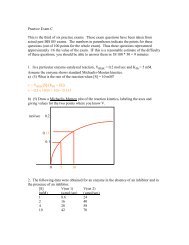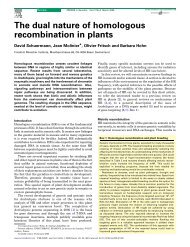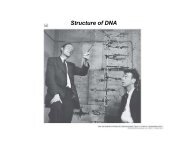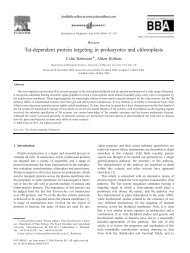use of a low-cost silicon diode-array spectroradiometer
use of a low-cost silicon diode-array spectroradiometer
use of a low-cost silicon diode-array spectroradiometer
You also want an ePaper? Increase the reach of your titles
YUMPU automatically turns print PDFs into web optimized ePapers that Google loves.
USE OF A LOW-COST SILICON DIODE-ARRAY SPECTRORADIOMETER TOMEASURE SOLAR UV-BTerence M. Murphy, Section <strong>of</strong> Plant Biology, University <strong>of</strong> California, Davis, CA 95616Presented at an NIST Conference on “Critical Issues in Air Ultraviolet Metrology,” May,1994 (unpublished)AbstractAn Ocean Optics S1000V spectrometer, equipped with a UV-sensitive <strong>silicon</strong> <strong>diode</strong><strong>array</strong> (glass cover removed) and a UV-transparent optical fiber input together witha MgO diffusive reflectance disk, was <strong>use</strong>d to measure global (whole-sky) UV-Bradiation. Reproducibility <strong>of</strong> the readings <strong>of</strong> the spectrometer using a standardlamp was about 5%. The calibration function [W m -2 (indicated unit) -1 ] <strong>of</strong> thesystem, determined by using a standard quartz-tungsten-halogen lamp,demonstrated interference peaks, the amplitudes <strong>of</strong> which were ±10% <strong>of</strong> the meansensitivity <strong>of</strong> the sensor. The scattering properties <strong>of</strong> the reflectance disk providedcosine-corrected irradiance values. The temperature effects on the dark current andthe light sensitivity <strong>of</strong> the sensor were significant, but not correlated, makingtemperature control important. Readings <strong>of</strong> solar radiation be<strong>low</strong> 300 nm wereovershadowed by dark-current noise and/or stray light. The instrument isinexpensive and easily portable and, with care given to calibration, can be <strong>use</strong>d tomeasure solar UV-B above 300 nm.IntroductionResearch on the effects <strong>of</strong> solar UV-B radiation on biological systems requires an accurateestimation <strong>of</strong> the effective incident radiation. Beca<strong>use</strong> the absorbance <strong>of</strong> UV-B radiation bymany biological molecular (e.g., DNA) varies greatly through this spectral region, in orderto predict the relative biological effects <strong>of</strong> different radiation sources it is necessary either t<strong>of</strong>ind a sensor with a spectral response like that <strong>of</strong> the molecule, tissue, or system in questionor to obtain irradiance spectra for the sources (1,2).Spectroradiometers that are sensitive in the UV region have been expensive, generally over$10K. Less expensive instruments that are assembled in the laboratory from amonochromator and photometer are <strong>of</strong>ten too clumsy for field students (3, personalexperience <strong>of</strong> the author). Recently, a new instrument has been developed by Ocean Optics,Inc. that is relative inexpensive and easily portable. This paper describes an evaluation <strong>of</strong>this instrument for biological research on UV effects, emphasizing certain precautions thatmust be taken when it is <strong>use</strong>d for field studies.EquipmentA spectrometer (Model S1000V, Ocean Optics, Inc., Denedin, FL) was equipped with aUV-transparent fiber optic input (50 µm diameter). In this spectrometer, the light from theoptical fiber impinges on a concave front-silvered mirror with a holographically inscribeddiffraction grating. The diffracted spectrum is directed to a <strong>silicon</strong> charge-coupled <strong>diode</strong><strong>array</strong>. In the UV-sensitive model, a glass plate is removed from the front surface <strong>of</strong> the<strong>array</strong>. The spectrometer was mated to a laptop computer through an analog-digitalconverted (Model CIODAS16JR, Computer Boards, Inc., Mansfield, MA). The s<strong>of</strong>tware<strong>use</strong>d for control <strong>of</strong> the spectrometer and data acquisition was either that provided with thespectrometer by the manufacturer or the more convenient C-SPEC (Ancal, Inc., Las Vegas,NV). The portability <strong>of</strong> the spectrometer comes from its size (12 x 13 x 4 cm 3 ) and the fact
that it draws its power from the computer. List prices (Ocean Optics, Inc.; Ancal, Inc.) as <strong>of</strong>1993 were: spectrometer, $1875; optical fiber, $148; analog-digital board, $499; C-CPEC,$580. The s<strong>of</strong>tware requires an IBM-compatible 80286 (or later model) computer. APack-in-Tell 386SX laptop computer (Computer Wareho<strong>use</strong>, Sacramento, CA) was selectedbeca<strong>use</strong> it could accept the analog-digital board directly.To <strong>use</strong> the spectrometer as a <strong>spectroradiometer</strong>, the data were calibrated to give an absolutereading <strong>of</strong> fluence (W m-2 nm-1) using a quartz-tungsten-halogen lamp with a calibratedradiance traceable to an NIST standard (Optronic Laboratories, Inc., Orlando, FL).Confirming values were determined using the output from a monochromator (Jobin Yvon)and a 250 W high-pressure Hg vapor lamp. The monochromator output was measured withan Eppley thermopile radiometer, which itself was calibrated using both a quartz-tungstenhalogenlamp with known energy output (measured electrically) and a laser, the energy <strong>of</strong>which was measured by a factory-calibrated Newport Corp. Model 835 Si Optical PowerMeter. A 100 W quartz-tungsten-halogen lamp (Model L7407, Gilway Technical lamp,Woburn, MA) was <strong>use</strong>d as a secondary standard.Spectral data were calibrated with respect to wavelength by noting the positions <strong>of</strong> linesfrom an unfiltered <strong>low</strong> pressure Hg vapor lamp.For measurement <strong>of</strong> global (sun plus sky) radiation, a reflectance disk was fabricated from apaste <strong>of</strong> magnesium oxide in water, which was pressed into a plastic mold, smoothed, andal<strong>low</strong>ed to dry. The optical fiber was positioned normal to the disk.ResultsAs measured with the spectrometer, the median width <strong>of</strong> Hg vapor lines at one-halfmaximum height was 2.0 nm (Fig. 1). This compared to the nominal resolutin specified bythe manufacturer (1.2 nm). At the highest sensitivity setting (integration time 4096 ms), thedark current was 10-15% <strong>of</strong> the maximum reading, considerably greater than specified bythe manufacturer. A set <strong>of</strong> eight readings <strong>of</strong> the secondary standard lamp (unregulatedpower supply) taken over one week and two cycles from full battery charge to “<strong>low</strong>battery” indication gave a coefficient <strong>of</strong> variation <strong>of</strong> 4.9%. Over the past 12 months, thewavelength calibration has drifted by less than ±0.8 nm.
Fig. 1. Line spectrum from an unfiltered <strong>low</strong> pressure Hg vapor lamp,placed ca 30 cm from the fiber optic input. Integration time was 2048 ms;10 scans were averaged. Inset: logarithmic plot, showing the symmetry <strong>of</strong>emission lines and the limits imposed by dark current noise and/or straylight.The sensor <strong>of</strong> the spectrometer was sensitive to temperature. By placing the spectrometer atdifferent temperatures in incubators in the laboratory, I found that the dark current was thesame at -7 o and 12 o C, but was higher at 25 o C and much higher at 30 o C. In contrast, thereading from a standard lamp (less the dark current) was fairly constant from 12 o to 30 o C,but was substantially <strong>low</strong>er at -7 o C (Fig. 2). Changes in dark current could be compensatedby using the values given by the “dead pixels” (pixels 1-15 and 1048-1100 on the <strong>diode</strong><strong>array</strong>), which also varied with temperature, but this procedure did not work for the lightresponse. In practice, it was best to insulate the spectrometer and minimize the differencesin temperature between the times that the instrument was calibrated and <strong>use</strong>d.
Fig. 2. Effect <strong>of</strong> temperature on <strong>spectroradiometer</strong> readings. Open squares,average <strong>of</strong> a set <strong>of</strong> 52 light pixels. Closed squares, average <strong>of</strong> dead pixels 1-15. Closed triangles, average <strong>of</strong> dead pixels 1048-1100. Each reading wasmade after the sensor housing had equilibrated to a chamber <strong>of</strong> a measuredtemperature; the optical fiber and the quartz-tungsten-halogen lamp remainedat a constant room termperature, and the position <strong>of</strong> the fiber relative to thelamp did not change when the sensor housing was moved from one chamberto another. Integration time was 4096 ms; 10 scans were averaged. In thedark, the readings <strong>of</strong> the dead pixels were precisely the same as in the light,and the readings <strong>of</strong> the light pixels were simlar to those <strong>of</strong> the dead pixels.Used directly, the 50-µm diameter optical fiber had an input sensitivity as a function <strong>of</strong>angle on incidence that was approximately triangular, dropping to zero for angles <strong>of</strong>incidence greater than 7.5 o from the fiber axis (Fig. 3). The maximum sensitivity <strong>of</strong> theinstrument was determined by aiming the sensor directly at a standard lamp (Fig. 4). On anenergy basis, the sensitivity at 300 nm was 0.52 times that at 450 nm; on a photon fluencebasis, the sensitivity ratio was 0.52(450/300) = 0.78. The calibration function showed aperiodic structure that was due to thin-layer interference by the SiO 2that formed the <strong>diode</strong><strong>array</strong> (M. Morris, Ocean Optics, Inc., personal communication).
Fig. 3. Sensitivity <strong>of</strong> the optical fiber-<strong>spectroradiometer</strong> system as afunction <strong>of</strong> the angular deviation <strong>of</strong> the lamp direction from the fiber axis.Fig. 4. Calibration function, showing the absolute sensitivity <strong>of</strong> the<strong>spectroradiometer</strong> system with the fiber pointed directly at a point source.The specified irradiances <strong>of</strong> a standard quartz-tungsten-halogen lamp weredivided by the spectrometer readings at the corresponding wavelengths (•).To approximate a continuous calibration function, a modified black-body
spectrum (6) with color temperature chosen to match the spectrum to thespecified irradiances <strong>of</strong> the standard lamp was divided by the spectrometerreadings (|). Finally, a function (B) was derived with a trend taken from asecond-order regression formula for the standardized irradiances (A) and aninterference component with amplitude and periodicity chosen to match thecontinuous function. The formula <strong>of</strong> the calibration function shown is:B =- 28.12 - 0.099λ + (1.001x10 -4 )λ 2 + (1.617 - 0.0028λ) sin (2π[6500/λ]- 0.5)To measure global solar radiation from sun and sky, the fiber was directed downward to ahorizontal MgO diffusive reflectance disk. In this mode, the response <strong>of</strong> the<strong>spectroradiometer</strong> was proportional to the cosine <strong>of</strong> the angle <strong>of</strong> incidence <strong>of</strong> the lightnormal to the disk (Fig. 5). The sensitivity <strong>of</strong> this system was calibrated by directing theoutput <strong>of</strong> the secondary standard lamp onto the disk. The reflectance <strong>of</strong> the disk was 0.70-0.95% and was considered to be a smooth function from 290-475 nm (Fig. 6 inset--thesharp peaks from 300 to 350 nm are though to be random variation from the <strong>low</strong> intensity<strong>of</strong> the reflected radiation <strong>of</strong> the standard lamp measured in this mode.)Fig. 5. Sensitivity <strong>of</strong> the diffusive reflection disk-optical fiber<strong>spectroradiometer</strong>system as a function <strong>of</strong> the lamp direction from a linenormal to the disk (and along the fiber axis).
Fig. 6. Calibration function for <strong>use</strong> with the MgO diffusive reflection disk,calculated as the product <strong>of</strong> the calibration functin for direct radiation (B,Fig. 4) with the reciprocal <strong>of</strong> reflectance (C, inset and formula be<strong>low</strong>). Thereflectance was measured by placing the sensor the standard distance fromthe MgO disk (8 cm) while illuminating the disk with the secondarystandard lamp at a measured distance (0.25 m) and angle (9.2 o ). Data forreciprocal <strong>of</strong> reflectance were obtained by the fol<strong>low</strong>ing calculation,Reciprocal <strong>of</strong> reflectance = [S(λ)/J(λ)][cos(9.2 o )π(0.5) 2 /π(0.25) 2 ],where S(λ) was the reading <strong>of</strong> the standard lamp measured by pointing thefiber directly at the source from 0.5 m and J(λ) was the reading <strong>of</strong> thereflected radiation. The right-hand expression corrects for the distance andangle <strong>of</strong> incidence <strong>of</strong> the standard lamp radiation on the disk. The functionC represents a third-order regression fit to the reciprocal <strong>of</strong> the data forreflectance and fol<strong>low</strong>s the equation,C = -938 + 8.97λ - 0.024λ 2 + (2.05x10 -5 )λ 3Fig. 7 shows the spectrum <strong>of</strong> global solar UV (and blue) radiation in April in Davis, CA; thestructure <strong>of</strong> the spectrum in the UV range is similar to that produced by more elaborateinstruments. The upper inset shows how the measured irradiance compared to thatpredicted by a semi-empirical analytical function (4,5). The <strong>low</strong>er inset shows a logarithmicploy, demonstrating the limits imposed be<strong>low</strong> 300 nm by dark current noise and/or straylight. A comparison <strong>of</strong> spectra taken at Lake Tahoe, CA and Davis, CA (Fig. 8) shows aratio, greater than predicted by the program <strong>of</strong> Björn and Murphy (4) on the basis <strong>of</strong>altitude alone, that may reflect the presence <strong>of</strong> ozone or other pollutants in the CentralValley.
Fig. 7. Global solar UV and blue spectral intensities, measured at Davis on26 April 1994, 1200 PST; data corrected for spectral sensitivity andreflectance <strong>of</strong> MgO disk (Fig. 6). Upper inset: UV-B portion <strong>of</strong> thespectrum, compared to values predicted by the DAYLIGHT program <strong>of</strong>Björn and Murphy (4), using appropriate parameters and three values, 3,4,and 5, for “aerosol.” Note that an aerosol value be<strong>low</strong> 4 overestimates theamount <strong>of</strong> UV-B reaching the Earth’s surface. Visibility at that time wasover 80 km in all directions. Lower inset: logarithmic plot.
ConclusionsFig. 8. A comparison <strong>of</strong> representative solar spectra in Davis, Ca (15 July1993, 1215 PST, 10 m altitude) and Lake Tahoe (25 July 1993, 1145 PSTam, 1920 m altitude). Six Davis spectra and four Tahoe spectra werecompared by t test: the difference at 340 nm was significant at the 5% level<strong>of</strong> confidence. Inset: ratio <strong>of</strong> the Tahoe spectral values to the Davis spectralvalues. Although visibility was excellent in both locations when the spectrawere taken, the higher ratio in the UV-B band suggests that the difference isdue to an accumulation <strong>of</strong> pollutants, including ozone, in the more populatedCentral Valley around Davis.The S1000V spectrometer provides the basis for an inexpensive, easy-to-operate, fieldportable<strong>spectroradiometer</strong>. Although subject to uncertainties generated by the limitedspectral resolution and stray-light rejection characteristic <strong>of</strong> a single-grating monochromatorand by temperature effects on both light and dark currents, the sensitivity[signal:(noise+stray light)] <strong>of</strong> the instrument above 300 nm for measurements <strong>of</strong> globalUV-B radiation reflected from a MgO diffusive reflectance disk, and the disk gives a goodcosine response. In using this instrument, the large uncertainty at wavelengths less than 300nm must be acknowledged.Is an instrument <strong>of</strong> this type <strong>use</strong>ful for studies <strong>of</strong> the biological effects <strong>of</strong> UV-B? Theanswer depends on the biological weighting function <strong>of</strong> the phenomenon being studied.This instrument cannot measure solar radiation at those wavelength most affected by ozone;however, a substantial proportion <strong>of</strong> solar damage to DNA and photosynthesis occurs fromwavelengths above 300 nm. Also, the <strong>spectroradiometer</strong> has some advantages relative to abroad-band meter, since its measurements can easily be adapted to different light sourcesand to living systems with different biological weighting functions. The <strong>low</strong> <strong>cost</strong>, simplicity,and portability <strong>of</strong> this instrument make it inevitable that it or similar instruments by othermanufacturers will be <strong>use</strong>d increasingly by physiologists and ecologists.
The complexity <strong>of</strong> the calibration curve (Fig. 4) emphasizes the importance <strong>of</strong> having astandard lamp readily available. The high <strong>cost</strong> <strong>of</strong> absolute spectral standards for the UVwavelengths presents a danger <strong>of</strong> data appearing in the literature from instruments that havenot bee calibrated or have been calibrated too infrequently. There is a need for lessexpensive standard lamps <strong>of</strong> reasonable, if <strong>low</strong>er, accuracy (5%).Acknowledgement--I am grateful to Jana Steiger, Laboratory <strong>of</strong> Chemical Biodynamics,University <strong>of</strong> California, Berkeley, for providing the standard lamp.References1. R.D. Rundel, “Action spectra and estimation <strong>of</strong> biologically effective UV radiation,”Physiol. Plant. 58:360-366, 1983.2. Y. Furusawa, K. Suzuki, and M. Sasaki, “Biological and physical dosimeters formonitoring solar UV-B light,” J. Radiat. Res. 31:189-206, 1990.3. W.F. Kaufmann and K.M. Hartmann, “Low <strong>cost</strong> digital <strong>spectroradiometer</strong>,”Photochem. Photobiol. 49:769-774, 1989.4. L.O. Björn and T.M. Murphy, “Computer calculation <strong>of</strong> solar ultraviolet radiation atground level,” Physiolgie Vegetale 23:555-561, 1985.5. A.E.S. Green, K.R. Cross, and L.A. Smith, “Improved analytic characterization <strong>of</strong>ultraviolet skylight,” Photochem. Photobiol. 31:59-65, 1980.6. J.C. DeVos, “A new determination <strong>of</strong> the emissivity <strong>of</strong> tungsten ribbon,” Physica20:690-714, 1954.








